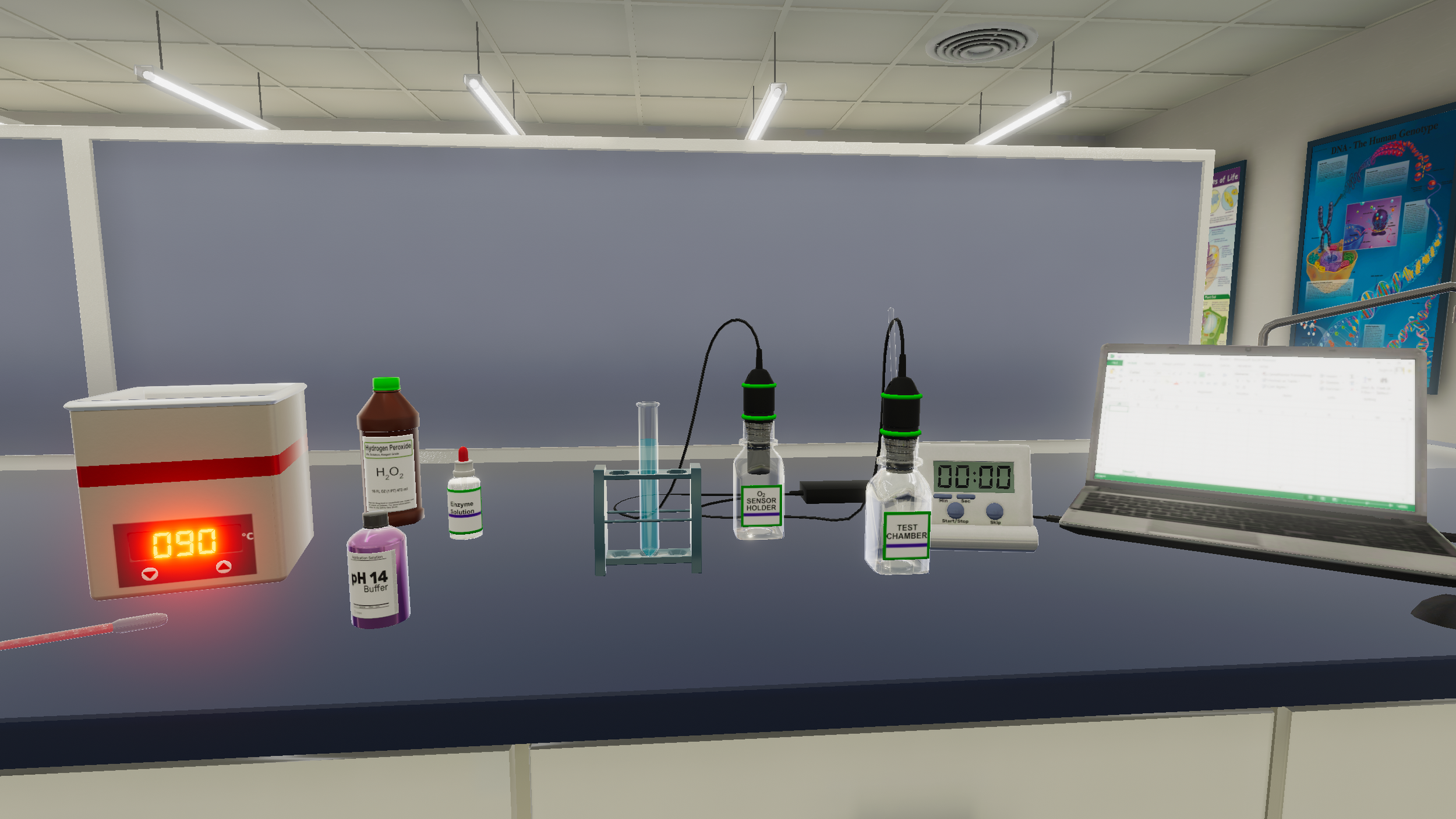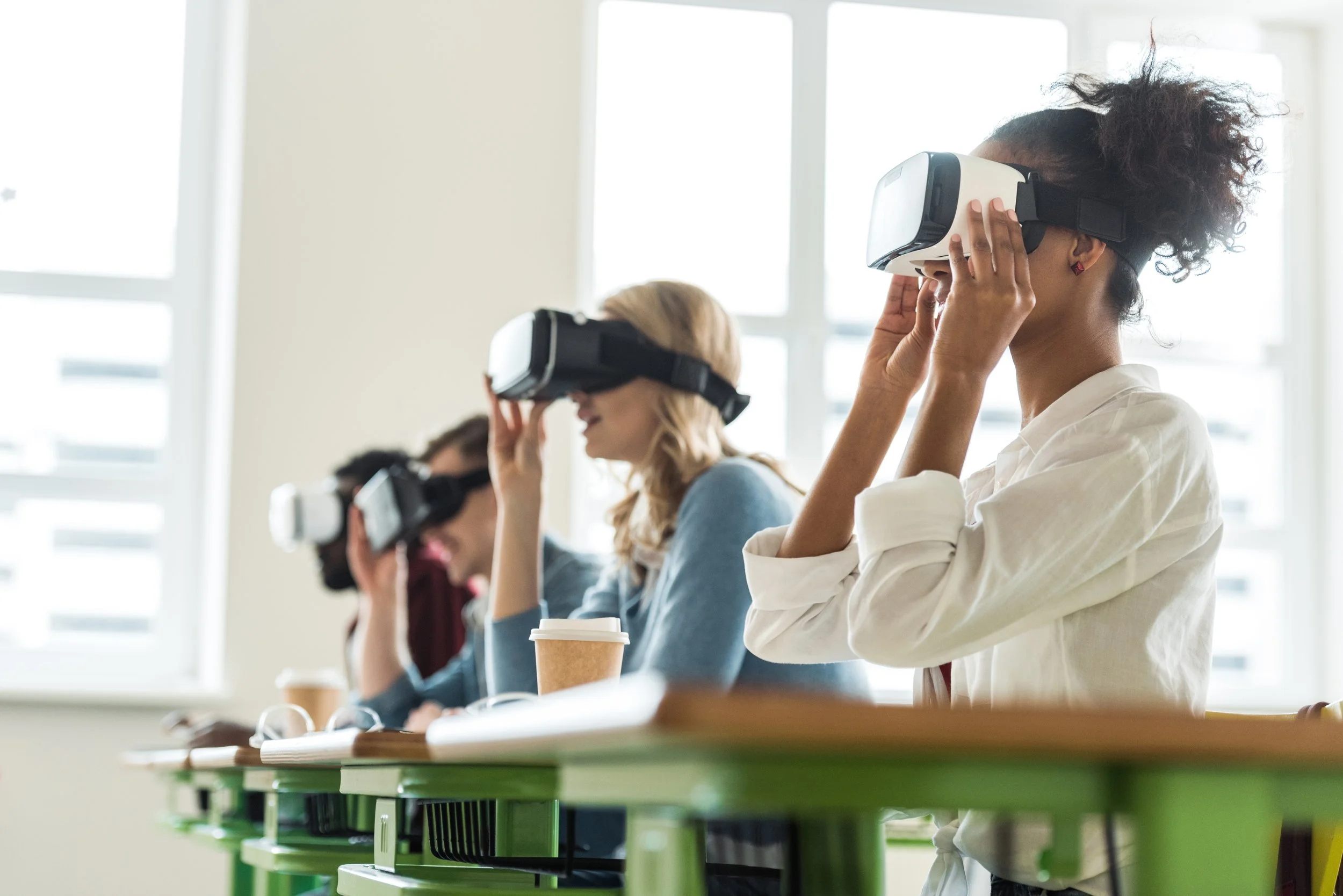Flat Screen vs. VR Headset: What’s Best for Immersive Learning?
It’s easy to get swept up in the sci-fi sheen of virtual reality headsets when it comes to virtual learning. Slip one on and suddenly you're standing inside a prehistoric forest or futuristic cityscape. The sense of presence is powerful, even transformative.
But does that mean students need VR headsets to engage meaningfully with immersive learning?
Here at UniVirtual, we’ve asked ourselves this question more than once. We’ve tested it too, in real classrooms. What we’ve found is this: VR headsets are exciting, but they’re not essential. When it comes to how well students understand, retain, and stay engaged with learning material, flat screen learning environments more than hold their own. In many cases, they even win on comfort, access, and ease of use.
In this blog, we go on a deep dive into what actually changes between these interfaces and what really drives impact when it comes to the virtual classroom environment.
Students at a virtual bench lab in UniVirtual
Two Portals to the Same World
On a flat screen, students navigate using their mouse and keyboard or a controller. It’s familiar, quick to pick up, and fits into existing routines. In immersive environments—not just clicking and dragging—they will walk an avatar around from a third-person perspective, common in video games.
With a VR headset, students are the avatar. They move in first-person, with motion-tracked gestures and full 360-degree vision. It’s more physically involved and sometimes more emotionally so.
Both modes offer different strengths, and both can support deep, memorable learning when they’re designed with care.
Our immersive environments are built to be cross-platform, so students can enter through a laptop or desktop (flat screen) or through a head-mounted display (VR headset). The world they explore is the same, but how they experience it shifts dramatically.
UniVirtual bench lab in first-person view
What Changes (and What Doesn’t)
Immersion & Embodiment
VR makes it easier to feel physically present. That kind of embodiment can help concepts stick, especially in subjects that are hands-on, such as using motion-tracking controllers to twist a microscope’s eyepiece.
Beyond interaction, VR offers an unobstructed, 360° field of view that closely mirrors real-world perception. This isn’t just visual: it lets learners inhabit scale and depth in ways flat screens can’t. Studies comparing immersive and desktop-based VR environments have found that full immersion combined with direct interaction improves spatial awareness and decision-making, helping users better understand size, volume, and relationships between elements. While flatscreen courseware can convey spatial data, this often requires more cognitive effort from the learner to interpret.
These strengths are especially visible in social learning. Presence in VR tends to foster more natural behavior. Students occupy space together in ways that feel closer to real-life interaction. Research suggests that this stronger sense of presence can enhance collaboration and lead to deeper engagement with tasks.
Flat screens, meanwhile, still deliver rich, immersive learning. When interactive tasks, strong visual design, and social presence all come together, students can feel deeply engaged, often just as much as they do with a headset. The difference isn’t binary; it’s a spectrum. Well-designed flatscreen experiences can be powerful, while poorly executed VR can feel disorienting or hollow.
Engagement & Retention
Studies show that virtual reality headset users often stay more focused, make fewer mistakes, and naturally engage in higher‑order thinking tasks like problem‑solving. That added presence can boost confidence and make learning feel more immediate.
However, great results aren’t limited to headsets. A 2025 study published in Education and Information Technologies found no meaningful differences in what students ultimately learned when comparing flatscreen and immersive headset setups.
In our experience, when flatscreen environments are well designed for exploration and decision‑making, they deliver engagement and retention that is on par with headsets. The difference isn’t the device itself, but how alive the learning experience feels to the user. We’ve found that what really makes students engage is having a reason to care, something to explore, puzzle through, and make decisions about. That’s true no matter what device they’re using.
Practicality: Cost, Comfort, and Access
Here’s where the flat screen shines. Not every school has a budget for multiple headsets. Not every learner finds VR comfortable, either. Some experience motion sickness, sensory overload, eyestrain, or just don’t want to strap something to their face for an hour or more.
Flat screen courseware runs on devices students already have or that are already free to use in their college library. They’re easier to scale, simpler to support, and more inclusive right from the start.
Designing for Both: Our Approach
We believe immersion isn’t about hardware. It’s about how an experience feels, and how much the learner can engage meaningfully. That can be fostered through thoughtful and interactive design, narrative and gamification, and clear, supportive pacing, regardless of the interface.
Here are some examples of how we bring both option to life:
Flat Screen
In our first-year biology program, students build molecular structures to understand how shape relates to function, travel through a 3D cell environment, cross-breed alien plants and track traits across generations, to name just a few of the experiences.
These all run on flat screens, and students love them. Instructors currently offering UniVirtual as part of their biology course consistently report stronger understanding and higher engagement compared to traditional textbook approaches.
Biskaabiiyaang: The Indigenous Metaverse’s player character in a VR headset environment
VR Headsets
For some of our virtual activities, VR opens doors that flat screens can’t. In our work with Indigenous communities, presence isn’t just a novelty; it’s a form of cultural respect. When learners enter the space in VR, they aren’t represented by an idle avatar with text bubbles. Instead, they are fully embodied, controlling their own movements and speaking with their own voice. It’s the difference between texting someone and sitting with them in conversation. That sense of being there changes how people behave. Communication becomes more thoughtful, respectful, and grounded in human connection rather than the semi-anonymity that can come with typed messages.
Students learn endangered Indigenous languages alongside fluent speakers inside landscapes that feel alive because they’ve been built from the ground up by and for community. They learn gestures, context, and worldview, not just vocabulary lists. It’s learning ways of being and fostering relationship building through virtual connection.
Even then, we keep access in mind: our environments are compatible with both headsets and flatscreens. With our older flatscreen projects that are used by thousands of students every year, upgrading their compatibility depends on whether the institution requires it. So far, it hasn’t come up!
Students in UniVirtual’s cellular respiration lab, preparing to don their shrinking suits
Final Thoughts: You Don’t Need a Headset to Make Learning Immersive
We’re big believers in VR, so much so that we build for it and value its potential. However, we don’t see it as a gatekeeper to virtual courseware.
A well-designed flatscreen experience can spark curiosity, deepen understanding, and connect learners to each other just as well as a headset. It lowers the barrier to entry without lowering the bar for quality.
If you're a STEM educator exploring immersive learning and wondering where to start, start with the screen. Headsets can come later, or not at all. It’s not about the gear, it’s about presence, curiosity, and helping students feel something new.






